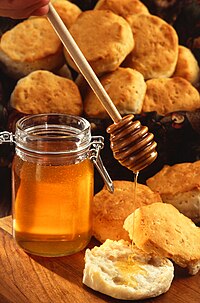
Photo from wikipedia
Simple Summary Honey bees collect a multitude of substances from plants, including nectar, pollen, and a lesser-known resin called propolis. Honey bees line their colonies with propolis to fill in… Click to show full abstract
Simple Summary Honey bees collect a multitude of substances from plants, including nectar, pollen, and a lesser-known resin called propolis. Honey bees line their colonies with propolis to fill in cracks and potentially aid in their defense against pathogens such as fungi, bacteria, and viruses. Different plants contain different types of chemicals that are collected by bees to form propolis, and so one would expect the plants that bees visit to influence the quality of the propolis contained within honey bee colonies. This project explored the chemical composition and antibacterial effects of propolis collected from apiaries that were surrounded by different types of land use patterns in Iowa. Propolis samples collected from colonies that were surrounded by the highest levels of agriculture had the lowest abundance of chemical compounds and also the lowest antimicrobial activity detected for two of the bacteria species studied. These results add to a growing body of work that suggests that high intensity agricultural land use negatively impacts multiple aspects of honey bee colony health. Abstract Honey bee propolis is a complex, resinous mixture created by bees using plant sources such as leaves, flowers, and bud exudates. This study characterized how cropland surrounding apiaries affects the chemical composition and antimicrobial effects of propolis. The chemical composition and compound abundance of the propolis samples were analyzed using Gas Chromatography-Mass Spectrometry (GC-MS) and the antimicrobial effects were analyzed using the 50% minimum inhibitory concentration (MIC50) assay against four relevant bee pathogens, Serratia marcescens, Paenibacillus larvae, Lysinibacillus sphaericus, and Klebsiella pneumoniae. Propolis composition varied significantly with apiary, and cropland coverage predicted mean sum abundance of compounds. The apiary with the highest cropland coverage exhibited significantly higher MIC50 values for S. marcescens and K. pneumoniae compared to other apiaries. These results demonstrate that agricultural land use surrounding honey bee apiaries decreases the chemical quality and antimicrobial effects of propolis, which may have implications for the impacts of land use on hive immunity to potential pathogens.
Journal Title: Insects
Year Published: 2022
Link to full text (if available)
Share on Social Media: Sign Up to like & get
recommendations!